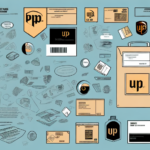Ensure Your Packages Arrive Safely with UPS Insured Shipping
In today's world of online shopping, shipping has become an essential part of the buying process, and ensuring the safe delivery of your packages is crucial. When it comes to shipping, there are many carriers to choose from, but UPS insured shipping is an excellent option for anyone looking for extra peace of mind. In this article, we will discuss the reasons why insured shipping is important, how UPS insured shipping works, the different levels of coverage provided by UPS, and the process of filing a claim if something goes wrong. We will also provide helpful tips for packaging your items safely and avoiding common causes of damage during transit.
Why Insured Shipping is Essential
Insured shipping offers numerous benefits that can safeguard your packages against various risks. Accidents during transit can lead to packages being damaged, lost, or stolen. With insured shipping, you gain protection against these unforeseen events, ensuring that you receive compensation up to the insured value of your package.
For high-value items such as jewelry, electronics, or collectibles, insured shipping can prevent significant financial losses. Additionally, providing insured shipping enhances customer satisfaction and trust, as recipients can be confident that their packages will arrive safely and intact. According to a comparing shipping carriers report, businesses that offer insured shipping options often see higher customer retention rates and fewer complaints related to shipping issues.
UPS Insured Shipping: How It Works
UPS insured shipping employs a comprehensive process to ensure that your package is protected throughout its journey. From the moment the package is handed over to UPS, it is tracked and monitored until it reaches its final destination. In the event of damage or loss, UPS covers the cost of repair or replacement up to the insured value.
Coverage Options
UPS provides various coverage levels to accommodate different shipping needs. The standard coverage includes $100 of basic coverage for all shipments. For items valued above $100, additional coverage can be purchased, extending up to a maximum of $50,000. This flexibility allows you to choose the level of protection that best fits the value of your shipment.
Moreover, UPS insured shipping covers protection against environmental factors such as weather-related damage, theft, and other unforeseen circumstances. This comprehensive coverage ensures that your package is safeguarded against a wide range of potential risks.
Determining Package Value and Filing Claims
Valuing Your Package
Accurately determining the value of your package is essential for proper insurance coverage. Start by considering the purchase price of the items being shipped. If you are shipping handmade or custom items, calculate the total cost of materials and labor. For unique or irreplaceable items, you may choose to insure them for more than their original purchase price to account for their sentimental or market value.
It's also important to consider the current market value of the items. If the item's value has increased since purchase, insuring it for the current market value ensures adequate protection. Conversely, if the item's value has decreased, insuring it for the purchase price may suffice. Accurate valuation helps in receiving appropriate compensation in case of loss or damage.
Filing a Claim
If your package is damaged or lost during transit, filing a claim with UPS is necessary to receive compensation. The claims process involves providing proof of the item's value, shipping and delivery documentation, and evidence of the damage or loss. UPS will review the claim and make a determination based on their investigation.
Be mindful of UPS's claim filing deadlines: for damaged packages, you must file within 60 days of the delivery date, and for lost packages, within 9 months of the shipment date. Missing these deadlines can result in denial of the claim. Additionally, UPS may require an inspection of the damaged items or packaging before approving the claim, so retain all packaging materials and the damaged contents until the claim is resolved.
Packaging Tips to Ensure Safety
Proper packaging is critical in preventing damage during transit. Here are some best practices to follow:
- Choose a sturdy box or envelope that appropriately fits your item.
- Use bubble wrap or other cushioning materials to protect against impacts.
- Position the item in the center of the package and surround it with cushioning to prevent movement.
- Seal the package securely with strong packing tape and clearly label it.
Additionally, selecting the right shipping method for your item is important. Fragile or high-value items may require special handling or additional insurance. Always verify the recipient's address and contact information to avoid delays or lost packages.
Avoiding Common Causes of Damage
Several factors can lead to package damage during transit, including rough handling, moisture exposure, and temperature extremes. To mitigate these risks:
- Avoid overpacking to prevent excessive weight and potential crushing.
- Use moisture-resistant materials to protect against damp conditions.
- Label packages containing fragile items clearly to ensure careful handling.
- Choose a shipping option that aligns with the specific needs of your package.
Proper labeling and using appropriate packaging materials are essential steps in minimizing the risk of damage during shipping.
Comparing UPS Insurance to Other Carrier Insurance Options
While UPS insured shipping is a robust option, it's beneficial to compare it with other carriers like USPS, FedEx, and DHL to determine the best fit for your shipping needs. For instance, USPS offers insurance coverage up to $5,000 for certain shipping services, whereas FedEx provides declared value coverage up to $100,000 for international shipments.
Factors to consider when comparing carrier insurance options include the value of the items being shipped, destination, shipping speed, and associated costs. Conducting thorough research and understanding each carrier's policies will help you make an informed decision that best suits your requirements.
Overall, UPS insured shipping stands out as a reliable choice offering comprehensive coverage and extensive tracking capabilities. By implementing proper packaging techniques and understanding UPS's insurance coverage, you can ensure that your packages are delivered safely and securely.
For more detailed comparisons and to choose the best shipping carrier for your business, visit our shipping carriers comparison page.




















